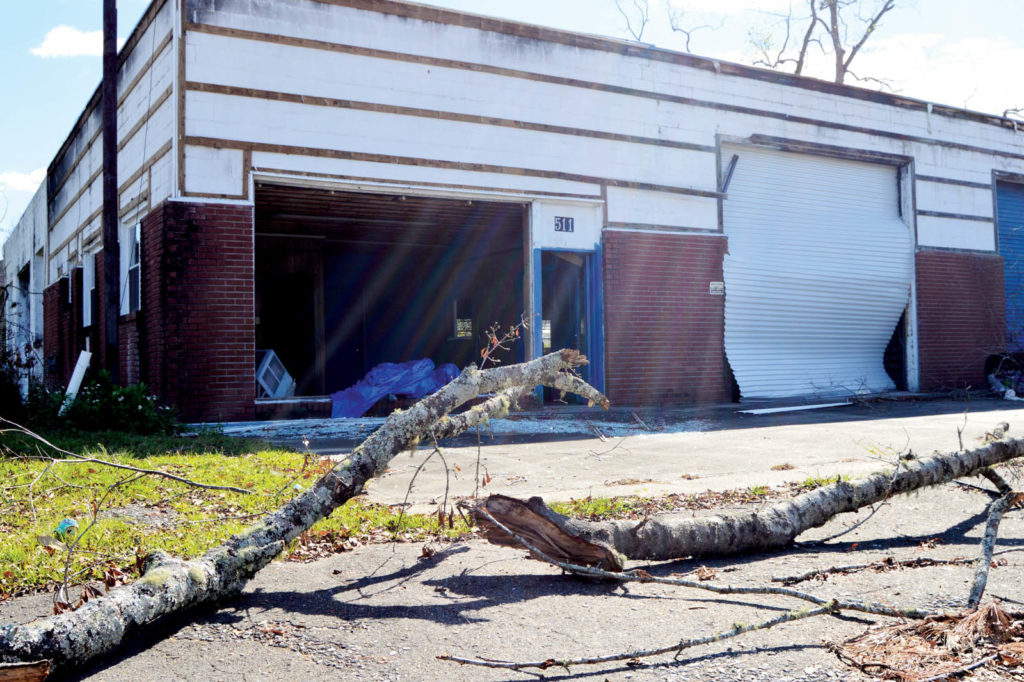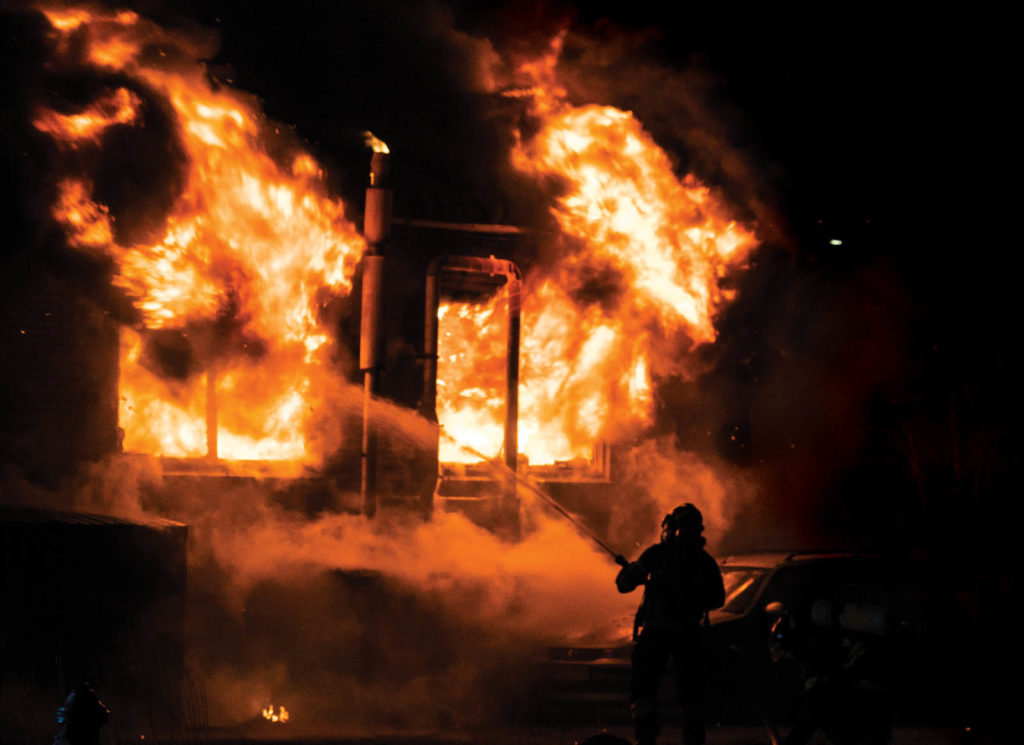
When Jeff Kleger got the call in February 2008 that the building housing his awning company was on fire, he was getting ready to head out of town with his wife and daughter for a weekend event. Instead, sending his family on without him, the president of 432 Design Inc. in Philadelphia, Penn., raced to his business, uncertain of what would await.
“It was mostly smoke and equipment damage,” he recalls. “The fire department wrecked the building to get in to stop the fire. They destroyed the wide garage doors, came in through the display window and cut holes in the roof. Our inventory was ruined. It was water, water everywhere.”
So were the difficulties. With orders to fill, closing the business would have been “catastrophic,” Kleger says, so they continued working, meeting their obligations with help from others in the industry.
“I shifted the IT to a laptop. I was well-prepared with backup files,” he says. “I picked up a cheap printer. Our facilities were a mess. It was four months before we were in temporary quarters; it was June 2009 before we were able to move into a new, bigger location. But everything that went out the door was first-rate with no hint of the struggle to produce what was required.
“I don’t know if I’ve truly expressed the trauma of the event,” Kleger continues. “Not knowing the future with so much on the line is sobering. It shakes you to the core.”

Anticipation and planning
Many business owners don’t consider how they would continue in the face of a natural disaster or other disruption such as fire, supply shortages, etc., but they should. And it’s not as farfetched an effort as it seems. Daniel Foley, founder of Daniel Foley SEO Consultancy, a London, England, company providing technical SEO audits, content marketing and link building, among other services, says any event can be planned for by creating a business continuity plan.
“Collect data on available resources and potential disasters,” Foley advises. “Think about the worst possible outcome. Your risk of natural disasters will vary greatly depending on your specific location. For example, unless you’re directly on the beach, you’re unlikely to be affected by a tsunami, yet flooding can occur everywhere. Also think about the recovery point objective (RPO), which is something most companies overlook.”
RPO is the amount of time a business has before data must be restored from a backup file in order for normal operations to resume, he explains.
Then, develop a written plan detailing how the company will deal with emergencies. Think small as well as big interruptions, Foley advises. Many companies overlook planning for more minor crises such as computer or equipment theft, or extended loss of power or internet service, which can still result in costly downtime.
The business continuity/disaster recovery plan should be comprehensive, including all departments, critical processes and “recovery time objectives,” says Kevin Fisher, general manager, recovery services, for Agility Recovery. Headquartered in Denver, Colo., the company offers software and physical recovery solutions to help businesses plan for, respond to and recover from business interruptions, as well as providing business continuity training and testing.
Planning is just part of what’s required.
“Businesses must also practice these plans via testing and exercising to ensure they will actually work in times of crisis,” Fisher says. “The managers and, if applicable, the board should be knowledgeable of and brought into these plans.
“Testing and exercising can be done in a variety of ways, ranging from walk-throughs and tabletop tests to company-wide, in-person exercises,” he continues. “After carrying out these exercises, companies should perform after-action reviews and make changes to their plans accordingly.”
Avoid assumptions when planning, Fisher advises. For example, businesses often think that during a widespread power outage, renting/purchasing generators will be an option. But demand for backup generators, fuel, connection services, etc., can swiftly outstrip supply.

Another mistake is failing to regularly review and revise contingency plans, says Foley. Consequently, when the need strikes, if certain components have changed—for example, if people tasked with specific recovery responsibilities have left, or if software upgrades have made some procedures obsolete—the plan may not be as effective.
Know what you have, not just inventory but the value of your equipment, furnishings, etc., as well as outgoing orders, says Kleger.
“Really, anything contributing to your company’s success that you can put a number on,” he says. “Have photographs and information stored off-site to back up your claim. And you must have adequate personal and business financial resources to carry you through the storm. Insurance payments will be few and far between while you and your adjuster argue with the carrier about what is covered by the policy.”
Don’t overlook cloud storage, Foley says.
“Scanning, uploading and synchronizing digital material to the cloud can serve as a means of creating backup,” he explains. “Because of this, you may access the data from anywhere, which is great for maintaining efficiency.”
Taking action
The first move after a disaster is assessing the damage—as much as is safe to do, says Fisher. Undertake a walk-through of the physical site to determine what needs to be recovered.
“Businesses should activate their business continuity and/or disaster recovery plans and begin restoring the most critical functions to keep the business afloat and communicate with employees about the next steps to take,” he says. “If they contract with a disaster recovery provider, they should get in touch as soon as possible to activate coverage.”
Kleger, who wrestled with unanticipated insurance issues, hired an adjuster to help him “flesh out” his claim since his inventory insurance was insufficient, requiring him to rely on business interruption insurance to bridge the gap.
Fisher says as many as 50-to-60 percent of small businesses that endure prolonged, disaster-related downtime never recover. Kleger’s did.
“We shifted away from residential customers to a more commercial model—hospitality and high-end clients,” he says. “The fire forced me to make needed changes that strengthened our business.
“But looking back, I wish I had had a better insurance agent who knew the industry and who could better assess our needs,” he continues. “Post-mortem isn’t the best way to run a company. We were lucky in that we had been in business 30 years at that point. Our well-developed customer base pulled us through.”
Pamela Mills-Senn is a freelance writer based in Seal Beach, Calif.
SIDEBAR: Tackling the “what ifs”
It’s not a natural disaster, but when a company’s owner or leader is suddenly unable to run the business or dies, it can feel like one—which is why succession planning is essential. Yet many small businesses overlook it, says attorney Steven Fried, president and general counsel of OliverClarity, Inc. Based in New York City, the company developed and manages the OlyverApp.com business management platform, an online service directed at entrepreneurs.
The consequences of a lack of succession planning can be severe, leading to fractures, power struggles, potential loss of revenues and even the business itself.
“Succession planning starts with the recognition by the owners that the business is distinct from the founders,
the shareholders, members and so on,” Fried explains. “The focus should be on maximizing the continued profitability and growth of the business.”
A succession plan should:
- Include owners or those with significant interests or who contribute personal time, work or ideas to the venture.
- Clearly define who holds decision-making authority and the chain of authority.
- Be unambiguous, tight and clear. “It should be reflected consistently in documentation including buy/sell agreements, corporate bylaws, operating agreements, contracts and anything else that establishes procedures, rights and responsibilities,” Fried says.
- Be reviewed by an attorney.
- Be updated to reflect business growth or changed circumstances.
“Review the plan at least annually and anytime there’s a major event—like the retirement, death or disability of an owner—to ensure it still makes sense,” Fried says.
SIDEBAR: Leading through a crisis
It’s one thing to be in charge when everything is going smoothly; it’s another matter when everything hits the fan. During times of crisis, a different type of leadership is required.
“Most leadership occurs under stable conditions,” says Ronald E. Riggio, Ph.D. “But in a crisis, the leader needs to take fast action—everything speeds up. And the usual procedures may not work, so the leader has to be adaptable, flexible and may need to innovate.”
Riggio, a Henry R. Kravis Professor of Leadership and Organizational Psychology at Claremont McKenna College, Kravis Leadership Institute in Calif., says the first step is making sense of the crisis.
“What is happening? Is safety a concern? If so, that needs to be immediately addressed,” he says. “How is it disrupting operations? What are the other implications?”
Next, Riggio says leaders need to:
- Make decisions. This may involve consulting with team members and other leaders/managers.
- Communicate clearly, directly and frequently. Employees need to understand what has happened and what is being done to address/resolve the crisis.
- Coordinate action/facilitate and encourage teamwork. “Lower-level managers/leaders need to also help coordinate, particularly when the top-level leaders are unavailable or cut off from others,” says Riggio, adding this is why it’s not only important that lower-level managers/leaders be prepared to take action, but that rank-and-file employees are as well.
Once the crisis passes, leaders should analyze what did and didn’t work, learning from the crisis in order to prepare for the next one.
“It’s important to engage in pre-crisis planning,” Riggio says. “Imagine possible crisis scenarios. Generate plans. Create crisis committees who can work to anticipate possible crises and develop strategies for dealing with them. By planning and anticipating ahead of time, the damage from the crisis can be much less severe.”
 TEXTILES.ORG
TEXTILES.ORG


